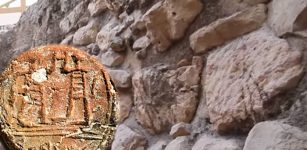Mysterious Enormous Underground Labyrinth Of Egypt Holds Secrets Kept From The Outside World
Ellen Lloyd - AncientPages.com - The lost labyrinth, full of hieroglyphs sculpted for eternity in its endless stone walls, is believed to contain all knowledge of ancient Egypt.
What secrets does this legendary giant underground complex contain? Could this be the most important discovery in human history?

Credit: Mulderphoto - Adobe Stock
Several ancient writers, such as Herodotus, Strabo, Diodorus, and Pliny, have described the Labyrinth of Egypt. The labyrinth's age and ancient origins are unclear, but it was more than 1,300 years old when Herodotus visited.
This legendary complex, named the "Labyrinth" by the ancient Greeks, is believed to be an enormous collective tomb of the twelve kings who built it and a resting place for sacred crocodiles. Located at Hawara, about 90 km south of modern Cairo, the complex contains secret chambers, passages, shrines, and tombs.
Herodotus wrote of the Labyrinth in the fifth century B.C. (History, 2.148-49): 'It has twelve covered courts - six in a row facing north, six south - the gates of the one range exactly fronting the gates of the other.
Inside, the building is of two stories and contains three thousand rooms, of which half are underground, and the other half directly above them.
I was taken through the rooms in the upper story, so what I shall say of them is from my own observation, but the underground ones I can speak of only from report because the Egyptians in charge refused to let me see them, as they contain the tombs of the kings who built the labyrinth, and also the tombs of the sacred crocodiles.
The upper rooms, on the contrary, I did actually see, and it is hard to believe that they are the work of men; the baffling and intricate passages from room to room and from court to court were an endless wonder to me, as we passed from a courtyard into rooms, from rooms into galleries, from galleries into more rooms and thence into yet more courtyards.
The roof of every chamber, courtyard, and the gallery is, like the walls, of stone.
The walls are covered with carved figures, and each court is exquisitely built of white marble and surrounded by a colonnade'.
For a long time, the true location of the Labyrinth remained unknown.
Since Herodotus visited the legendary labyrinth of Egypt 2500 years ago, the building disappeared in the midst of time.
In 1888, Professor Flinders Petrie located the actual site of the Egyptian Labyrinth. Sufficient of the original foundations remained to enable the size and orientation of the building to be roughly determined. The Labyrinth was about 304 meters [997 feet] long and 244 meters [800 feet] wide. In other words, it was large enough to hold the great temples of Karnak and Luxor!
In his writings, Herodotus described a nearby pyramid to be at the corner of the labyrinth. This was the Hawara pyramid. Could this offer a clue to the location of the Labyrinth?
When the Mataha Expedition scanned parts of the base area at Hawara in 2008 they found a strong suggestion of complex chambers and walls several meters thick beneath the surface to a considerable depth.
The research team's findings confirmed that there were archeological features to the south of the Hawara pyramid of Amenemhat III. The scannings showed vertical walls of an average thickness of several meters, which were connected to form quite a number of closed rooms.
Reconstruction of the Egyptian labyrinth by Athanasius Kircher. Copperplate engraving (50X 41 cm) “Turris Babel Sive Archontologia”, Amsterdam 1679.
The scanned surfaces were at the Labyrinth area south of the pyramid. One area was 150m by 100m on the right side of the Bahr Wahbi and on the left side 80m by 100m.
Therefore, the team had proven the Labyrinth existed given the huge dimensions, but the total size and shape could not yet be concluded. The underground water and the presence of the canal had an effect on the consistency of the survey.
There were rooms underneath. What Petrie had called the basin was in fact the ceiling!
The Mataha Expedition had made one of history's greatest discoveries without even excavating. There lay underground the legendary Labyrinth of Egypt.
Unfortunately, this amazing discovery was never heard of because the Egyptian government opposed the outside world should learn about the findings.
The Mataha Expedition results were published in the fall 2008 scientific journal of the NRIAG and the results were exchanged on the public lecture at Ghent University. Shortly thereafter, Secretary-General of the Supreme Council of Antiquities (Egypt) asked for a stop to communicating the results owing to the Egyptian National Security sanctions. The researchers waited patiently for Dr. Hawass to make the findings public.
It never happened. So, the team set up a website and posted their findings.
The Mataha Expedition's discovery is extraordinary, but no further attempts have been made to investigate the Labyrint. It is vital that the Labyrinth will once again be brought to daylight and presented to humanity.
How long will the Labyrinth and all its secrets be forgotten this time?
Our member section offers a wealth of informative and insightful articles similar to this one. Upgrading to a premium membership gives you ad-free access to our entire collection of articles, allowing you to explore and enjoy our content without interruptions.
Updated on July 7, 2024
Written by - Ellen Lloyd – AncientPages.com
Copyright © AncientPages.com All rights reserved. This material may not be published, broadcast, rewritten or redistributed in whole or part without the express written permission of AncientPages.com
More From Ancient Pages
-
 Prehistoric Human Migration In Southeast Asia Driven By Sea-Level Rise – Study Reveals
Archaeology | Feb 6, 2023
Prehistoric Human Migration In Southeast Asia Driven By Sea-Level Rise – Study Reveals
Archaeology | Feb 6, 2023 -
 Siberian Neanderthals Were Intrepid Nomads – They Started Their Journey In Eastern Europe
Archaeology | Jan 29, 2020
Siberian Neanderthals Were Intrepid Nomads – They Started Their Journey In Eastern Europe
Archaeology | Jan 29, 2020 -
 New Last Ice Age Findings In Palawan Cave
Archaeology | Sep 19, 2022
New Last Ice Age Findings In Palawan Cave
Archaeology | Sep 19, 2022 -
 Cerberus – Giant Multi-Headed Dog Guards The Underworld Of God Hades In Greek Mythology
Featured Stories | Jun 2, 2020
Cerberus – Giant Multi-Headed Dog Guards The Underworld Of God Hades In Greek Mythology
Featured Stories | Jun 2, 2020 -
 Mystery Of The Giant Laos Jars Continues – New Discoveries Reported By Scientists
Archaeology | Apr 19, 2021
Mystery Of The Giant Laos Jars Continues – New Discoveries Reported By Scientists
Archaeology | Apr 19, 2021 -
 Unique 2,700-Year-Old Seal That Belonged To ‘Governor Of The City’ Of Jerusalem Discovered
Archaeology | Jan 2, 2018
Unique 2,700-Year-Old Seal That Belonged To ‘Governor Of The City’ Of Jerusalem Discovered
Archaeology | Jan 2, 2018 -
 LIDAR Advanced Technology Spotted Rare Pre-Columbian Florida Village – Highly-Prized Producer Of Beads
Archaeology | Nov 10, 2019
LIDAR Advanced Technology Spotted Rare Pre-Columbian Florida Village – Highly-Prized Producer Of Beads
Archaeology | Nov 10, 2019 -
 Artificial Intelligence Reveals The Out Of Africa Expansion Is More Complex Than Previously Thought
Archaeology | Oct 18, 2021
Artificial Intelligence Reveals The Out Of Africa Expansion Is More Complex Than Previously Thought
Archaeology | Oct 18, 2021 -
 On This Day In History: Battleship USS Maine Explodes And Sinks – On Feb 15, 1898
News | Feb 15, 2017
On This Day In History: Battleship USS Maine Explodes And Sinks – On Feb 15, 1898
News | Feb 15, 2017 -
 Surprising And Fascinating Finds On The Wreck Of The Lootsi Cog
Archaeology | Nov 27, 2023
Surprising And Fascinating Finds On The Wreck Of The Lootsi Cog
Archaeology | Nov 27, 2023 -
 Unique Viking Age Arm Ring Found On Öland And Stunning 2,000-Year-Old Gold Torc Discovered In Trollhättan, Sweden
Archaeology | Mar 19, 2025
Unique Viking Age Arm Ring Found On Öland And Stunning 2,000-Year-Old Gold Torc Discovered In Trollhättan, Sweden
Archaeology | Mar 19, 2025 -
 Science Unravels Some Secrets Of Mysterious Shipwreck Gribshunden
Archaeology | Sep 17, 2022
Science Unravels Some Secrets Of Mysterious Shipwreck Gribshunden
Archaeology | Sep 17, 2022 -
 Seppuku: Ancient Suicide Ritual That Guaranteed Honorable Death Instead For Life In Shame
Ancient Traditions And Customs | Mar 8, 2018
Seppuku: Ancient Suicide Ritual That Guaranteed Honorable Death Instead For Life In Shame
Ancient Traditions And Customs | Mar 8, 2018 -
 Two Vikings From The Same Family Reunited After 1,000 Years
Archaeology | Jun 15, 2021
Two Vikings From The Same Family Reunited After 1,000 Years
Archaeology | Jun 15, 2021 -
 On This Day In History: Maximilien Robespierre Sent To The Guillotine – On July 28, 1794
News | Jul 28, 2016
On This Day In History: Maximilien Robespierre Sent To The Guillotine – On July 28, 1794
News | Jul 28, 2016 -
 Ennion: Ancient Master Of Glassblowing And His Legacy
Artifacts | Dec 7, 2020
Ennion: Ancient Master Of Glassblowing And His Legacy
Artifacts | Dec 7, 2020 -
 New Evidence Of Human Habitation At Panga ya Saidi Cave, Kenya That Dates Back 78,000 Years
Archaeology | May 11, 2018
New Evidence Of Human Habitation At Panga ya Saidi Cave, Kenya That Dates Back 78,000 Years
Archaeology | May 11, 2018 -
 ChatGPT Is Confronting, But Humans Have Always Adapted To New Technology – Ask The Mesopotamians, Who Invented Writing
Featured Stories | Feb 13, 2023
ChatGPT Is Confronting, But Humans Have Always Adapted To New Technology – Ask The Mesopotamians, Who Invented Writing
Featured Stories | Feb 13, 2023 -
 Astonishing Secrets Of Legendary Kachinas: Watchers Of The Hopi
Civilizations | Apr 8, 2017
Astonishing Secrets Of Legendary Kachinas: Watchers Of The Hopi
Civilizations | Apr 8, 2017 -
 Early European Farmers Traced To Anatolia, DNA Study Shows
Archaeology | Jan 5, 2016
Early European Farmers Traced To Anatolia, DNA Study Shows
Archaeology | Jan 5, 2016




